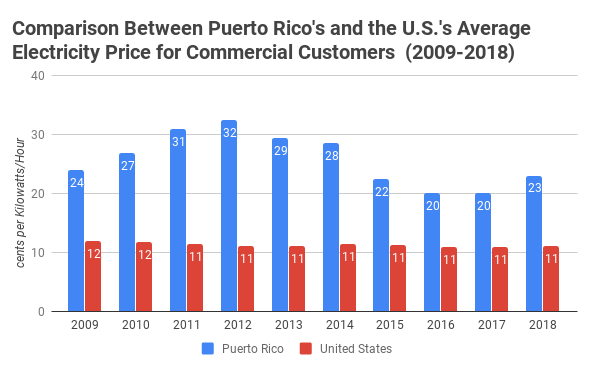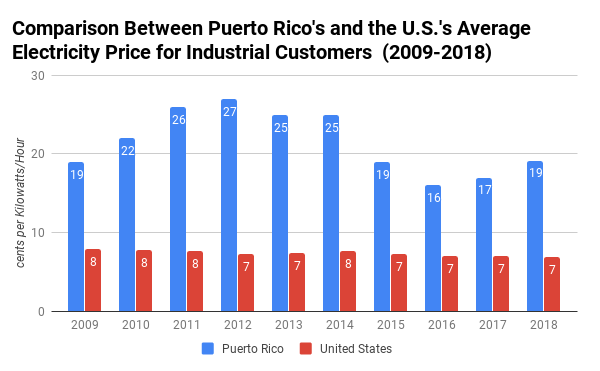One of Puerto Rico’s main economic challenges is the high cost of electricity. As I noted in an early post, the island’s residents pay one of the highest electricity rates in the United States. For the past three years, the Financial Oversight and Management Board (FOMB), established by the U.S. Congress to oversee Puerto Rico’s finances and to restructure its debt, have instructed the Puerto Rico Electric Power Authority (PREPA) to set the the price to 21 cents per kilowatt/hour (kWh) by 2023. Ricardo Rossello, Puerto Rico’s pro-statehood governor who wants to privatize PREPA, promised last year that PREPA would to reduce the rate to 20 cents kWh. The Puerto Rico Manufacturers Association in an effort to increase its members’ competitiveness have lobbied the island’s government to reduce the electricity rate to 15 cents kWh.
Can PREPA deliver lower electricity rates? In the short-term, it will be unable to meet Rossello’s 20 cents kWh target. If a new deal to restructure a part of PREPA’s $9 billion is approved by Judge Laura Taylor Swain and Puerto Rico’s legislature, PREPA will pay off the new bonds by levying its customers a new surcharge. Starting this summer, the electricity rate will increase by 1 cent to 23 cents per kWh. In July 2020, the surcharge increases to 2.8 cents per kWh and over the years it will keep increasing up to 4.6 cents per kWh until the bonds are paid off.
Although many Puerto Ricans have voiced their opposition to this deal, Governor Rossello expects that the projected hikes will be balanced by his government’s reform of PREPA, which includes the privatization of its assets and the conversion of some of its power plants from oil to natural gas. While Puerto Ricans may see lower electricity rates in the future, it is clear that the price for electricity will increase in the short-term.
These rate hikes will be an extra burden on Puerto Rican families and businesses. While Puerto Rico’s residents do not pay the highest electricity rate in the United States, the island’s median household income is really low. Meaning that Puerto Ricans tend to devote higher percentage of their income to pay for electricity.
The next graph compares Puerto Rico’s median household income for 2017 with the median household income for the U.S. It is worth noting that these are the latest figures, calculated by the U.S. Census.
To put it perspective, the median American family spent 2.4% of their household income on electricity. At 29.5 cents per kWh, Hawaii’s price for residential electricity in 2017 was the highest in the United States. But, the state’s median household income was $74,493. Thus, Hawaiians were spending around 2.4% of their income on electricity.
For example, the residential electricity rate in Hawaii for 2017 was 29.5 cents per kWh. But the state’s median household income was $74,493. Thus, Hawaiians were spending 2.4% of their income on electricity.
Using this formula, we notice that Puerto Rico’s median family spends 4.2% of their income on electricity.
| Year | Median Household Income | Percentage of Median Household Income Devoted to Electricity |
| 2014 | $19,686.00 | 3.75% |
| 2015 | $19,350.00 | 5.0% |
| 2016 | $19,606.00 | 4.5% |
| 2017 | $19,775.00 | 4.2% |
While the amount of income devoted to electricity is lower than in 2015, the new rates hikes will reverse recent gains. The next graph already includes the proposed increase for 2019. Thus, Puerto Ricans will once again experience a steep rise on electricity costs.
While forecasting the future impact these rate hikes will have on the Puerto Rican economy is difficult, the sad reality is that at least in the short-term the rising cost of electricity will burden the island’s economy, squeezing family incomes, forcing some businesses to close, or hampering the Puerto Rican government’s efforts to attract new investments.
Note: A version of this post can be found in my blog, The Puerto Rico Data Lab. Follow me in Twitter: @cyordan or @pr_datalab.



